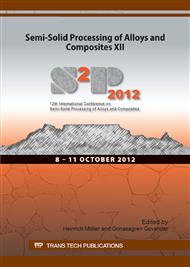p.76
p.83
p.89
p.95
p.101
p.109
p.116
p.123
p.130
Reduction of Hot Tearing of Cast Semi-Solid 206 Alloys
Abstract:
The mechanical properties of 206 alloys are among the highest of aluminum alloys. However, these alloys are usually prone to hot tearing. It is known that the addition of silicon can reduce the hot tearing propensity and improve fluidity. However, the commercial 206 alloys used in conventional casting processes limit the silicon concentration ≤0.05 wt% to obtain good mechanical properties. However, the semi-solid forming offers a unique opportunity to increase the silicon content to improve the castability without compromise on mechanical properties. In the present paper, the development of modified 206 alloy compositions to minimize hot tearing during semi-solid forming while maintaining competitive mechanical properties is reported. The effect of high silicon contents with varying copper levels on hot tearing sensitivity is studied. The mechanical properties of a high Si 206 alloy with lowest hot tearing sensitivity are evaluated. It is found that increasing the silicon content in 206 alloys is beneficial to reduce hot tearing. The high Si 206 variants produced by the SEED rheocating process not only reduce significantly the hot tearing sensitivity but also attain superior mechanical properties.
Info:
Periodical:
Pages:
101-106
Citation:
Online since:
October 2012
Authors:
Price:
Сopyright:
© 2013 Trans Tech Publications Ltd. All Rights Reserved
Share:
Citation:


